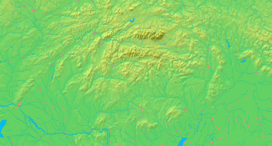Old Town, Bratislava
| Staré Mesto | |
| Borough | |
.jpg) Bratislava's main square. | |
| Country | Slovakia |
|---|---|
| Region | Bratislava |
| District | Bratislava I |
| River | Danube |
| Elevation | 130 m (427 ft) |
| Coordinates | SK 48°08′36″N 17°06′27″E / 48.14333°N 17.10750°ECoordinates: SK 48°08′36″N 17°06′27″E / 48.14333°N 17.10750°E |
| Area | 9.59 km2 (3.703 sq mi) |
| Population | 42,241 (2005) |
| Density | 4,405/km2 (11,409/sq mi) |
| First mentioned | 907 |
| Postal code | 81421 |
| Area code | +421-02 |
| Car plate | BA, BL |
  Location of Staré Mesto in Slovakia
| |
| Website: www.staremesto.sk | |
| Source[1] | |
The Old Town of Bratislava (Slovak: Staré Mesto) is the historic center and one of the boroughs of Bratislava, in the Bratislava Region of Slovakia. It is coextensive with the smallest Slovak administrative district by area, Bratislava I. It contains the small, but preserved medieval city center, Bratislava Castle and other important landmarks. Bratislava's Old Town is known for its many churches, a riverbank promenade and cultural institutions, it is also the location of most of the foreign states embassies and important Slovak institutions including the National Council of the Slovak Republic; the Summer Archbishop's Palace, seat of the Government of Slovakia; and Grassalkovich Palace, seat of the President of Slovakia.
Location
The Old Town is bordered by the river Danube to the west, Karlova Ves to the north, the New Town to the north and east, and Ružinov to the east and south.
Division
The Old Town is divided into several local parts: the historical center, Vydrica, Zukermandel, Blumentál, and others. Some of the local parts were demolished by the Communist government after World War II, including Vydrica and Zukermandel.
Characteristics
As its name suggests, the district houses many historic monuments and Bratislava's central institutions. It also contains many Slovak governmental offices and institutions, such as the Ministry of Interior, the Ministry of Culture, and the Ministry of Justice.
The western part of the district is a hilly area (technically part of the Small Carpathians mountain range) featuring Bratislava Castle, the Slavín monument, Horský park (literally Mountain(ous) Park), many detached houses, and most of the foreign embassies in Slovakia. The hilly area ends in the south at the Danube with the Chatam Sofer Memorial and the Bratislava Castle hill, and in the west at the D2 Motorway. This part of Bratislava is more quiet than the other parts of the city's Old Town and, apart from the castle, it is seldom visited by tourists.
The eastern section is the historical and administrative center. Notable buildings and spaces include the Grassalkovich Palace, Trinity Church, Bratislava's Town Hall, St. Martin's Cathedral, Michael's Gate, the Primate's Palace, Comenius University, the main railway station (Hlavná stanica), the Slovak National Theatre (both the old and new sites), SNP Square, the Main Square (Hlavné námestie), Hviezdoslav Square (Hviezdoslavovo námestie), Kamenné námestie ('Stone Square'), Obchodná ulica ('Shop Street' equivalent to High Street), Pharmacy Salvator, Zochova Street from the 14th century and many other old churches and palaces. There are still some remnants of the medieval Bratislava city walls, although not open to the public for the time being.
Mayors
- 1990–1994 – Miloslava Zemková (DS)
- 1994–1998 – Andrej Ďurkovský (KDH)
- 1998–2002 – Andrej Ďurkovský (KDH)
- 2002–2006 – Peter Čiernik (KDH)
- 2006–2010 – Andrej Petrek (independent, later SDKÚ-DS, expelled in 2008)
- 2010–2014 – Tatiana Rosová (SDKÚ-DS)
- 2014–present – Radoslav Števčík (independent)
Twin town
See also
References
External links
- Official website (Slovak)
Gallery


 A typical paved street in Bratislava's Old Town district
A typical paved street in Bratislava's Old Town district Old Town from the castle hill
Old Town from the castle hill Old Town from the Nový Most bridge
Old Town from the Nový Most bridge